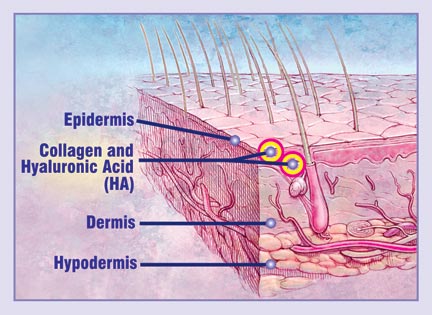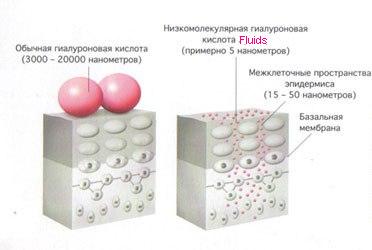Hyaluronic acid (hereinafter HA) - is a polysaccharide widely distributed in body tissues. It is one of the most important components of connective tissue, intra-articular (synovial) fluid, the vitreous eye. A lot of it is contained in the eggs, bones, heart valves, muscle, brain and skin.
| Develop specific HA cells - fibroblasts. A man at a young age fibroblast function active, and produce a sufficient number of Hyaluronic acid. But closer to 30 years of age to develop it gradually decreases.
Therefore, usually after 30 years of trouble began to appear, such as skin thinning, increased intraocular pressure. At the same time violated the relationship between cell surface and deep layers of the skin, there are wrinkles and loss of even a pink complexion. |
 |
The functions of hyaluronic acid
Hyaluronic acid binding in the intercellular space of the water, it increases the resistance of the tissue compression. One molecule of Hyaluronic acid is capable of holding around 500 to 1,000 water molecules. Only 1 gram of HA can retain up to 6 liters of water! Also, Hyaluronic acid is involved in the distribution of water in the tissues of the body, determines the barrier and protective functions of the intercellular space, helps to normalize the pressure inside the eye and acts as an intra-articular lubricant.
The use of hyaluronic acid in cosmetics
|
Once the properties are known to hyaluronic acid, it began to be widely used for correction of age-related changes of the skin, restoring elasticity, hydration and elasticity, eliminate dryness and wrinkles. Preparations with Hyaluronic acid used in cosmetic and plastic surgery to return the skin of youth and beauty. Very popular is the use of drugs with her for contouring and mesotherapy. Cosmetics manufacturers are actively developing various means of introducing into the formulation CC salt - Eye gels, lip balms, emulsions, creams, shampoos, wound healing products, etc. |
 |
But there are important points to be aware of.
Existing forms of hyaluronic acid
Currently, HA is available in the form of three types of drugs :
- animal origin, obtained directly from animal tissues (most often it is extracted from rooster comb or human umbilical cord). They have a high allergenicity ;
- synthesized specifically derived microflora. These types of GC have low allergenicity, and the relative safety of an infectious, but over time their effectiveness is weakened due to the imperfections of the strains of staphylococci, which are used in the biosynthesis of HA ;
- vegetable origin, produced in Japan from the algae and kinuaki (gelatinous root vegetable), have the highest quality and zero allergenicity. This GC is only sold in the domestic Japanese market, so it must be ordered through their former patients of Japanese .
What the Japanese did better ?
Hyaluronic acid in the skin contributes to the formation of elastin and collagen, which are concentrated around it, forming a framework that supports the skin. Over time, HA is resorbed, and collagen in the skin is a framework for a long time preserving its elasticity.
The creation of an internal skeleton of the skin, I think the main anti-aging properties of HA. Its ability to retain moisture in the skin is weaker than, for example, urea.
With such a wonderful and necessary properties for the skin, HA, however, has a very big disadvantage, which until recently prevented its full use in cosmetics: a very large size of HA molecules. The size of one molecule of HA is 2-3 times larger than the average size of cells and 13,8 times greater than the extracellular space.
Koichi Tanaka, Japanese scientist in 2002 received the Nobel Prize for developing methods for the identification and structural analysis of biological macromolecules. Simply put: he managed to create a CC with a low molecular weight, which was able to penetrate into the deeper layers of the skin and retain moisture, and its frame, while maintaining the free intercellular space. |
 |
Hyaluronic acid, once the body is subjected to the disintegration of the enzyme hyaluronidase. Incidentally, the famous Soviet-era drug lidasa - this is hyaluronidase obtained from bovine testis. In the body of this enzyme is released in response to the intracellular concentration of body fluids. Synthesized using stafilokkov CC consists of very large molecules rapidly fill and overlying the inner intercellular channels of the skin, so the body in response to the HA in the body distinguishes this enzyme to dissolve it. This explains the gradual decrease in the efficiency of a hyaluronic acid, as well as an undesirable effect produced by a HA - clogging of skin pores. Devoid of these shortcomings, the Japanese Hyaluronic acid, because its molecules are very small. Due to this the concentration of the gel can be increased to 3.5%, while the synthetic HA - 0.5-1.0%.
Positive aspect of the Japanese Hyaluronic acid is to improve the blood supply to the brain (for use on the face). And as a result - improved hair growth and a significant decrease in gray. When the news show the parliament or the government of Japan, look closely at the Japanese people: most of them are over 60, and their heads are generally dark and thick hair.
Another favorable property of the Japanese Hyaluronic acid is that it accumulates in the skin and over time it increases and decreases the effectiveness of its spending.
The composition of Hyaluronic Gel Fluids
Fluids used in the gel, hyaluronic acid is only produced in Japan, produced from natural ingredients: seaweed and vegetable kinuaki.
- pure hyaluronic acid 3.5%, the highest quality Food Grade;
- artesian water;
- extracts of: argan tree fruit, jojoba, avocado, tea tree, calendula.
Contraindications
- if you are hypersensitive hyaluronic acid;
- in autoimmune diseases ;
- during exacerbation of chronic diseases ;
- with acute infectious diseases of the skin.
The cost of the gel
20 ml jar - costs $ 37.
This amount is sufficient for 3-4 months of use for the face and neck.
|


